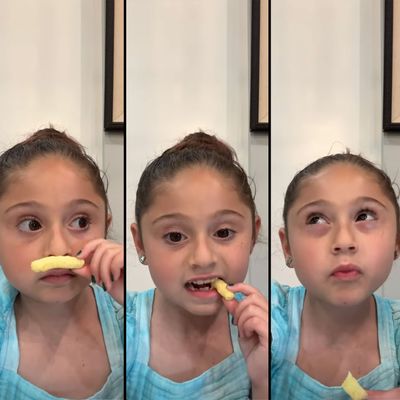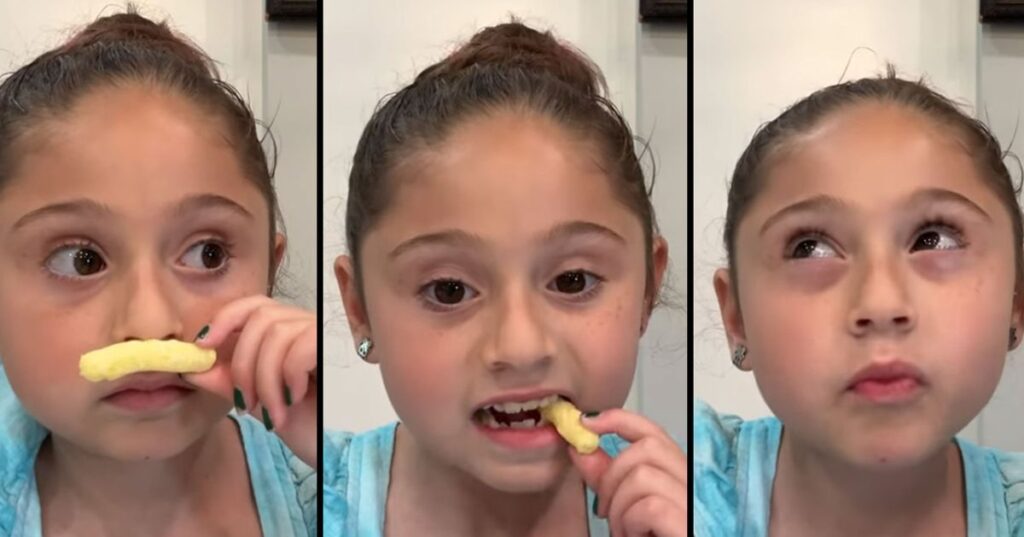
Photo-Illustration: by The Cut; Photos: myARFIDlife
Hannah first felt a deep-rooted anxiety around food when she turned 6. Whenever she visited her grandparents’ or a friend’s house for a meal, she would get nervous about having to turn down foods she didn’t like. Some of them — broccoli, Brussels sprouts — would make any kid turn up their nose. But even the possibility of mac ’n’ cheese or cake being offered at the dinner table would make her lose her appetite. She recalls picking up her older brother from a sleepover and noticing that his breath smelled like peanut butter — he’d had a PB&J for breakfast at his friend’s house. Because of its sticky and slimy texture, simply being in proximity to it made her panic, making it difficult to share the backseat with her brother.
“I get scared, I start crying, I get sweaty, and my legs start shaking,” says Hannah, now 8, when explaining how her body typically reacts to the prospect of having to try a new food or interact with a food on her fear-food list.
This was more complex than picky eating. Even subtle exposure to certain foods would send her into sensory overdrive. At age 7, Hannah was diagnosed with ARFID, which stands for avoidant/restrictive food intake disorder, a relatively newly known eating disorder first introduced for diagnosis in 2013. Unlike other more commonly recognized eating disorders like bulimia or anorexia, which are rooted in body dysmorphia and weight loss, ARFID is attributed to fear and anxiety surrounding food and its consumption. Although the terminology has been around for over a decade, the disorder has received minimal mainstream attention. Prior to its official designation in Diagnostic and Statistical Manual of Mental Disorders, it was treated under various amorphous labels such as selective eating, food refusal, food phobia, and food-avoidance emotional disorder. Although most commonly associated with children in early infancy or early childhood, without proper care, it can extend into adulthood.
To get Hannah to try new foods, her mother, Michelle, started filming her. “I would say, ‘Why don’t we take a video, so we can send it to your therapist,’” says Michelle. “It was honestly the only way she would eat anything new.” Then she thought, Why not start an Instagram account dedicated to it? Hannah had always liked being on-camera; she had a personal YouTube channel where she would make dance videos. Posting on a whim, Michelle says, they didn’t think to make the account, called, Myarfidlife, private. After a video of Hannah eating chicken soup at age 5 went viral, they decided to keep it public. For Hannah, who had often felt like no one understood her due to ARFID, connecting with others around the world going through similar struggles made her feel less isolated. “It’s what we call a ‘carrot,’” Michelle says. “She’s willing to challenge her eating disorder for the carrot of helping people through her Instagram,” she says.
The videos are always presented the same way: Hannah introduces herself, explains that she has ARFID, and announces the food she is going to be trying. Then, she takes three bites. The three-bite rule was created by Hannah to hold herself accountable to giving new foods a fair chance, the idea being that by the third bite enough of the initial fear might subside to allow her brain to decide how she feels about it. As she eats, she describes, in hyperspecific detail, the flavors and textures and the emotions associated with them. A snap pea tastes like “a scoop of grass”; roasted purple cauliflower has notes of “rubber.” She likens milk to water with a bitter aftertaste. In a taste test of mashed potatoes, Hannah wrinkles her nose and tells the camera that it smells like egg and that she feels uneasy because of the mushy texture.
There is something entrancing about how ritualistically Hannah repeats this process in video after video. Soon after she started posting, hundreds of thousands of views began to roll in, with the account amassing over 1.5 million followers. In part, her videos have found such a broad audience because they impart the delight and surprise of trying a new food for the first time, with each moment a bite-size step toward making peace with the unknown. “We’ve had people send us emails, other kids with ARFID who tell us that they’re using Hannah’s three-bite method, too,” Michelle tells me when I sit down to speak with her and Hannah. “They’re copying me,” Hannah says jokingly. The comments are a mix between cheer section and online forum, with curious followers, many of whom are parents themselves, asking questions about the specifics of Hannah’s experience. Skeptics also weigh in, comparing Hannah’s journey to a classic case of picky eating that has been allowed to go too far. This is nothing new for Michelle, who encountered the same response from friends and other parents when Hannah was first diagnosed. “We would constantly get advice like, ‘It’s because you have so many snacks in your pantry. Clear out all the snacks in your house, and I promise she’ll get hungry and eat,’” says Michelle, who recalls the frustration and alienation comments like this would spark. “I would sit and think to myself, You don’t understand I’ve tried that already. I’ve exhausted all of my options.”
As a mother to three, Michelle has dealt with a range of picky eating habits. Her oldest son, now 13, is autistic and has his own preferences. “I saw many similar characteristics with my son and Hannah. For example, if their French fries had potato skins on the bottom they would both peel them off,” she says. While she had always been able to use promises of extra playtime and sweets to cajole her other children into eating their vegetables, she realized Hannah’s aversion was different when these tactics fell flat. In fact, things got worse. When Hannah was 5, she started getting migraines, which caused nausea and cyclical vomiting, making it difficult to make sure she was getting necessary nutrition. If a food didn’t look right at dinner, Hannah would refuse to sit at the dining table. “It got to a point where if she was in the house while I was cooking a food that she didn’t like, she would come screaming and crying, saying ‘You know how I can’t stand how that smells,’” Michelle recalls.
Eventually, Hannah stopped being able to put on weight. When she fell off the growth chart, doctors warned that she would have to be put on a feeding tube if the situation became more dire. (This is a common last-resort treatment for children who wrestle with ARFID and are in dire need of nutritional rehabilitation.) After asking around at her son’s school, another parent suggested that Hannah might be struggling with ARFID. When Michelle brought the possible diagnosis to Hannah’s pediatrician, “they didn’t really say yes or no,” she recalls. “So I had to personally track down a therapist who specifically specializes in ARFID.” Due to the lack of resources and research around ARFID, there are no easily accessible therapists in California, where the family lives, so Hannah has virtual appointments with a therapist in Texas.
Danielle Gordon, Hannah’s therapist, has specialized in eating disorders since 2013. She received her first patient with ARFID while working at UC San Diego’s eating-disorder treatment center that year. Over her career, she has seen an uptick in ARFID cases as awareness around the proper language has increased. For many, she says, ARFID can be traced to a specific moment. “It’s not true for all cases, but most can pin it back to a certain time,” says Gordon, “One example would be someone’s kiddo getting sick on Christmas Eve on popcorn. Now, all of a sudden they won’t go near popcorn, and every time the Christmas lights come out their fear is heightened.” She likens it to a perfect storm, an unpleasant occurrence aggravating an existing sensitivity. “Our brain says, ‘Oh, I didn’t like that experience.’ And since our brains are trained to protect our body from anything we perceive as a threat, it’s natural to start avoiding the food associated with that moment.”
For Hannah, food gets broken down into categories — safe foods, foods she’s tried and likes, and fear foods. “A safe food is a food where I can go ‘I’m hungry, how about I have this?’ without having any anxiety,” Hannah explains. Making videos has helped her verbalize her specific likes and dislikes, better informing what makes it into which category. For example, she tends toward snack-size prepackaged foods because they are less likely to be stale and she hates foods that have a “carrot crunch.” She keeps a list on her bedroom wall of all of the foods she’s tried through the account. Since she’s started posting videos, she’s tried over 100 new foods, and her safe food list, which includes items like animal crackers or string cheese, has expanded to include seven new foods. Foods on the list with hearts marked next to them, like Honeycrisp apples, are foods that she likes but haven’t made it to the safe-food list. Then there are major fear foods, like ketchup or broccoli. These she doesn’t make videos about, but she works on them in private with her eating-disorder therapist.
“This is Mr. ARFID,” says Hannah, holding up a scrap of paper. Mr. ARFID has gravity-defying stick-straight hair and wiggly arms and legs; his face is permanently etched into a frown. “Let me show you what I do with him next,” she says giggling before crumpling up the piece of paper and throwing it. Mr. ARFID is a tool that Hannah was introduced to in therapy — “I’m supposed to listen to Mr. Brain instead of Mr. ARFID, who usually tells me that I’m not going to like a food or that it’s going to make me sick.” According to Gordon, these tools are important for treating eating disorders in children. “We want to externalize the anxiety and show these kids that they are not anxiety or ARFID,” she says.
Despite what it may look like on the Myarfidlife account, Hannah’s journey with ARFID isn’t linear. If she doesn’t incorporate the new foods she’s tried consistently into her diet, she might redevelop anxiety around them. There are good days and bad days. Navigating virality, especially when it has to do with one’s own health, has been expectedly tricky for Hannah and her family. Hannah realized the extent of her fame when she set up a stand on the corner of her neighborhood block to sell slime, which she makes as a hobby. (“I don’t mind the texture when I don’t have to eat it,” she clarifies.) A car pulled over within ten minutes to ask if she was the girl from Instagram. Another time, someone at Target asked for a photo with her.
There are, of course, the negative comments on her account, which Hannah isn’t allowed to see. Instead, Michelle reads Hannah a curated selection of the positive comments. “My husband gets upset; he can’t stand to look at the comments. I don’t let it bother me, though,” says Michelle. She admits there have been people close to the family who have distanced themselves or refuse to watch the videos because they see them as exploitative. (Michelle emphasizes that they do not make money from the videos.) Despite virality, Michelle says, there is no pressure for Hannah to continue making videos — if and when she decides that making videos no longer benefits her, they will stop. “I know that as a mom, I’m doing what’s best for my kid,” she says. “I know the amazing progress she’s made, and I don’t really care what other people have to say beyond that.”
Stay in touch.
Get the Cut newsletter delivered daily
Vox Media, LLC Terms and Privacy Notice

